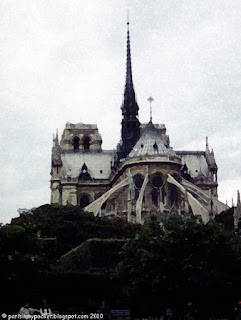Plate XXVI – Musee Picasso…
 Pablo Picasso was Spanish … and yet, oh so French.
Pablo Picasso was Spanish … and yet, oh so French. My favourite Picasso work – his Seated Harlequin of 1923 is sadly not found in Paris (it is in the Kunstmuseum Basel, in Switzerland). I was introduced to the painting, on a miniature scale, in an art calendar many years ago; fortuitously some time later I acquired a full sized print, on canvas. It was however, this specific work that started my fascination with and interest in the artist whose sometimes unintelligible (to me) abstract works I had previously dismissed.
Musée Nationale Picasso is located in the Hotel Sale in the Marais district of the city. Despite the highly visible banners proclaiming its presence I had some trouble finding it. Pablo Ruiz y Picasso was born in Malaga in Spain in 1881, and became the most influential artist of the 20th Century. His lifelong love of Paris started in 1900 and he moved there permanently in 1904. It was in Paris that he discovered colour although he never became fully at ease with it and his works remained a combination of typically duller Spanish tones with some of the vivacity of his colour loving French contemporaries. His work evolved to include many styles of art, as well as various media including sculpture and ceramics. He and Georges Braques are acknowledged as the fathers of Cubism. Although continuously moving from one artistic style to another, and there is a defiance of art conventions in all his work, it is perhaps for his prodigious output and great commercial (and financial) success that Picasso will be best remembered.
Picasso once described himself as the greatest collector of Picasso’s in the world. This was fortunate for Paris, for when he died, his heirs took advantage of a French law allowing his estate duties to be paid with art assets (deemed of value to the nation) in place of cash – a dation. The foundation of the collection of this museum were two ’dations Picasso’, the first on the death of the artist, the second on the death of his widow (and final muse) Jacqueline Roque.
The collection also includes works owned by Picasso by (amongst others) Cezanne, Degas, Matisse and Seurat. His many periods or styles as well works in his different chosen media, along with virtually all his life’s preliminary studies, are all represented in the exhibition at Musée Picasso.
Picasso died in Mougins in 1973.



























